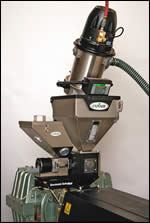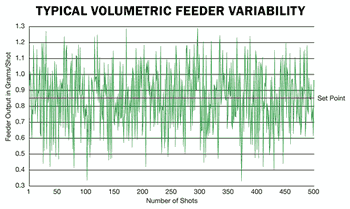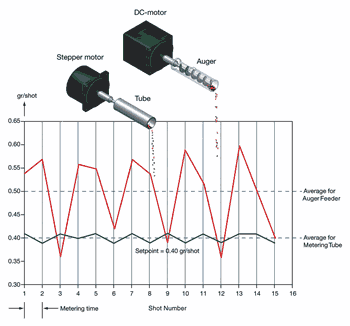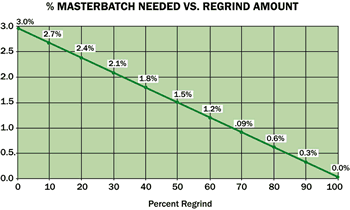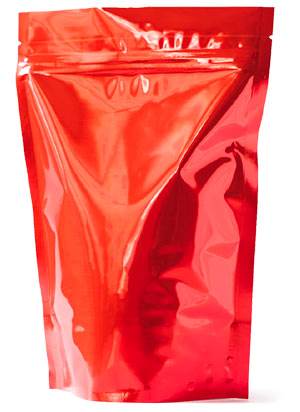Coloring on the Machine: You Can Do It Right
Coloring at the machine can offer significant cost benefits, including lower material inventory costs and improved process flexibility when compared with the cost of buying precolored resin or installing a large-capacity central blender to premix resin and color concentrate.
Coloring at the machine can offer significant cost benefits, including lower material inventory costs and improved process flexibility when compared with the cost of buying precolored resin or installing a large-capacity central blender to premix resin and color concentrate. While coloring at the machine should be relatively simple and efficient, more than a few things can go wrong. As such, it is essential to understand the process of coloring at the machine, typical coloring problems and their solutions, and the impact of coloring on the bottom line.
The three basic problem areas with on-machine coloring are delivery of the right ratio of colorant to virgin resin; calculation and delivery of the right ratio of colorant to a virgin/regrind material mix; and clean-up and changeover from one color to another.
Two ways to meter
Typically, coloring at the machine involves a color feeder installed at the base of the main material hopper on the processing machine. Once installed and calibrated, the feeder meters colorant through a throat adapter where it mixes with the main stream of natural resin before plastication in the barrel of the machine. Assuming the colorant ratio is correct, and there is no problem with the quality of the colorant itself, most coloring problems at the machine have to do with the quality and accuracy of the feeding equipment.
The amount of colorant metered out can be controlled by volume or by weight. Until relatively recently, most color feeders had been volumetric, whereby the colorant was fed by an auger screw, with the feed rate calculated based on the volume of the colorant passing through each turn of the screw. Such a feeder is calibrated by cycling the feeder at a certain speed, catching and weighing a series of samples, and comparing the sample weights to ensure the auger is dispensing consistently.
Although volumetric feeders have lower prices than gravimetric types and perform well in many coloring and additive feeding applications, they require a significant amount of time and labor for setup, calibration, and recalibration. Also, they tend to have higher operating costs, as their dispensing rates are not as accurate as with volumetric metering, which often leads processors to compensate by overfeeding.
Weight-based or gravimetric feeding has now become the preferred method for compounders, yet this technology has been prohibitively expensive, often costing $10,000 or more for the simple feeders commonly used on individual plastics processing machines. Such feeders utilize a load cell that continually registers the loss in weight of the colorant hopper and adjusts the feeder control to maintain the target feed rate. By comparing the delivery setting (i.e., grams/sec) with the actual changes in hopper weight during the same period, these devices are essentially self-calibrating and self-regulating.
Due to their dispensing accuracy, they typically provide a higher level of predictability and operate with consistently lower colorant and additive costs. The recent introduction of gravimetric units starting at about $3500 (less than 25% more than a conventional volumetric feeder), is making this technology much more attractive for the average processor.
Color plus virgin
Adding color to virgin resin is a simpler situation than if colored regrind is also present. Colorant and/or masterbatch manufacturers provide recommended colorant-to-resin mixing ratios. For example, a particular color may be added at a ratio of 25:1, which is equal to 4% of the total material mix. Still, getting the ratio right demands that you calibrate your feeder to ensure that it can and does deliver the right amount of color, make sure your processing equipment is running smoothly, and maintain the correct ratios throughout the course of the job.
What do you do when products are incorrectly or insufficiently colored; colorant costs are higher than anticipated; and excessive labor is being consumed by problems with feeder calibration or maintenance and/or job changeovers?
As a first step, you should ascertain that the colorant feed-rate setting is correct. If it is, but too little color is getting into the product, a tempting quick fix would be to simply adjust the colorant ratio upwards—say, from 4% to 5%. While this may solve the immediate problem, it could mask other problems, since coloring consistency is affected by factors such as the type and bulk density of the material, pellet geometry and flow, feeder behavior (screw, motor, control), and small errors in measurement or calibration.
Of all the above, measurement and calibration errors are the most common. Calibration can take time—a volumetric feeder may require collection and individual weighing of up to 12 samples to predict the appropriate level of accuracy. Even then, variations in collection method, number of samples, rounding errors, and bulk density of the colorant masterbatch can introduce additional error into the turn-volume/weight calculations that predict accurate colorant delivery in a volumetric feeder. Figure 1 illustrates the inherent variability of the typical volumetric feeder. To ensure that the necessary minimum dose of colorant is always delivered, processors often raise the setpoint. This can be costly, as shown in Table I.
Extremely high or low colorant delivery rates may also complicate the coloring process. Even when the feed augers are properly calibrated, the volume they deliver typically varies from dispense to dispense based on turn speed, colorant particle size and geometry, and vibrations from the processing machine. While these variances typically average out and don’t affect quality on routine jobs, they can be very difficult to manage without the continuous self-monitoring and self-calibration functions of gravimetric technology. It’s no surprise that tests show significantly higher variability in dispensing consistency and per-dispense material consumption for volumetric feeders compared with gravimetric feeders.
The behavior of a feeder is also affected by its metering technology. A simple auger may keep colorant flowing, but may dispense more in the first half of the rotation than the last. While this pulsing or surging behavior would not affect the total amount of material dispensed over long periods of time, it could complicate the process of sample collection and make accurate calibration more difficult.
There are alternative metering technologies, such as the rotating metering tube, which dispenses colorant in an even stream without surges. Figure 2 compares the flow from an auger and a metering tube necessary to ensure a minimum 0.40 gm/shot dispense rate. The auger surges colorant for part of its rotation, then delivers little or nothing for the rest. However, the dispensing tube meters out colorant very consistently, making everything from feeder calibration to downstream mixing and melting more predictable and easier to manage.
| Table I—Over-Coloring Is Costly | ||
| Machine throughput | 150 lb/hr | |
| Additive target amount | 4% | |
| Additive used/hour | 6 lb | |
| Additive cost | $3/lb | |
| Additive cost/hr | $18 | |
| Productive hours/year (3 shifts x 5 days x 50 weeks) | 6000 hr | |
| Additive cost/year | $108,000 | |
| Cost of Over-Coloring | Actual % Dispensed | Added Cost/Year |
| 10% over target | 4.4% | $ 10,800 |
| 20% over target | 4.8% | $ 21,600 |
| 30% over target | 5.2% | $ 32,400 |
| 40% over target | 5.6% | $ 43,200 |
| 50% over target | 6.0% | $ 54,000 |
While boosting the colorant level until color consistency is achieved is one to way fix a coloring problem, there is no precise way to determine how much extra colorant is really needed to make the difference. In addition, the cost of that extra colorant adds up quickly. Using the earlier example, an adjustment from a recommended ratio of 4% to 5% to solve color-variation issues represents a 25% increase in colorant usage level and cost.
Coloring regrind + virgin
Maintaining consistent color when there are changes in the quantity of virgin and regrind material can be a challenge. Regrind can usually be assumed to have the same percentage of color as the finished product and therefore is similar to precolored material in that it does not require additional masterbatch. Figure 3 shows how much masterbatch will be needed to color the virgin material with which the regrind is being mixed.
Thus, if you are running 10% regrind, you only need 90% of the color you would have needed if you were running 100% natural resin. As shown in the graph, if you would normally add 3% masterbatch to 100% natural resin, you only need 1.7% masterbatch when running a 10%-regrind/90%-natural resin mix.
Dual gravimetric feeders for regrind and color can be provided with controls slaved together to accomplish this goal automatically.
Cleanup and changeover
The amount of processing-machine downtime and labor costs associated with feeder cleaning and changeover can be considerable and can vary significantly by feeder type. To simplify cleaning and to minimize labor and downtime costs, look for these features in a feeder: easy disassembly and reassembly, easy access to key feeder components with minimum disassembly, and easy removal of leftover colorant or interchange of the colorant hoppers.
To know how important easy cleaning and changeover are to your choice of feeder design, ask yourself how often colorants or other additives are changed in your plant. How long does each clean-out take—five, eight, or 15 minutes? Thanks to continued advances in design, the latest feeders can be disassembled and cleaned in as little as one minute.
| Table II—Automatic Calibration Saves Time & $$ | |
| Calibration time/day (20 min/change x 3 changes) | 60 min |
| Production days/year (5 days/wk x 50 wks/yr) | 250 days |
| Calibration time/year (60 min x 250 days) | 250 hr |
| Machine-hr rate | $45/hr |
| Potential savings with automatic calibration | $11,250/yr |
Once a feeder is cleaned, how long does it take to set up and calibrate? How many adjustments are needed before color dispensing is consistent? How often is recalibration needed? Table II shows how automatic calibration can save time and money.
Your own experience will help you decide whether you can afford to buy a gravimetric feeder—or whether you can afford not to.
A microprocessor-controlled feeder will enable faster setups based on previous color or job records. But how fast it can be set up depends on the type of feeder—volumetric or gravimetric. Assuming that inputting setpoints requires equal time for both feeder types, the key difference is how much time is needed for feeder calibration before or during the job. While that will vary among different volumetric feeders, calibration time is essentially zero with gravimetric feeders.
Gary Hovis is product manager for blenders and feeders at Conair in Pittsburgh. Hovis has been with Conair since 1986, serving in product-management, sales, and engineering capacities involving all types of auxiliary equipment offered by Conair
Related Content
Additive Masterbatches for Monomaterial PE Film Applications
Ampacet’s Biax4CE portfolio of additives and white color concentrates designed for MDO-PE and BOPE applications.
Read MoreThe Steps to Consistent Color in Plastics
Unlock the secrets to flawless color duplication in your production processes. Discover why expert color replication is paramount for maintaining quality, reducing costs, and ensuring client satisfaction and retention. Download now to gain insights that will revolutionize your approach to color control.
Read MoreHow to Optimize Color Evaluation of Recycled Plastics
The right color measurement instrument and good working methods will minimize variability in color evaluation of PCR.
Read MoreMultilayer Solutions to Challenges in Blow Molding with PCR
For extrusion blow molders, challenges of price and availability of postconsumer recycled resins can be addressed with a variety of multilayer technologies, which also offer solutions to issues with color, processability, mechanical properties and chemical migration in PCR materials.
Read MoreRead Next
Lead the Conversation, Change the Conversation
Coverage of single-use plastics can be both misleading and demoralizing. Here are 10 tips for changing the perception of the plastics industry at your company and in your community.
Read MoreBeyond Prototypes: 8 Ways the Plastics Industry Is Using 3D Printing
Plastics processors are finding applications for 3D printing around the plant and across the supply chain. Here are 8 examples to look for at NPE2024.
Read MoreMaking the Circular Economy a Reality
Driven by brand owner demands and new worldwide legislation, the entire supply chain is working toward the shift to circularity, with some evidence the circular economy has already begun.
Read More



